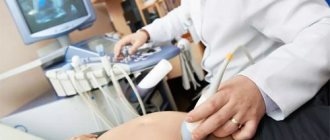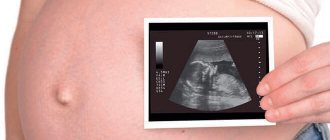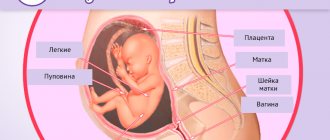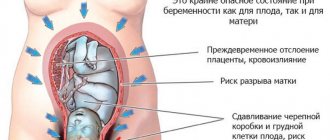Pregnancy is often accompanied by discomfort in the lower abdomen. Pain, pulling sensations, colic - all this can also have a natural origin, accompanying the growth of the fetus and stretching of the uterus. But sometimes some disease becomes the source of pain, and this symptom cannot be ignored. Now let’s try to figure out how to distinguish one from the other.
Types of pain
Pain in the lower abdomen can be aching, pulling, stabbing, sharp and weak, but everything can be grouped into two large categories according to their origin. These are obstetric and non-obstetric.
Obstetrics include pain in the lower abdomen, the causes of which are pathologies such as premature placental abruption, ectopic pregnancy, and threatened miscarriage.
The second group is even more voluminous: it combines pain caused by stretching of the ligaments supporting the uterus, problems of the gastrointestinal tract, surgical pathologies and a number of other reasons.
Pathological causes
Pain and regular tingling in the perineum during pregnancy are a symptom of disturbances in the functioning of the mother’s body:
- Vaginal infection. The expectant mother's immune system weakens and is often unable to cope with pathogenic bacteria, viruses and fungi. Failure to comply with personal hygiene rules and wearing synthetic underwear contribute to the development of vaginal infection. The inflamed area feels tingling, burning and shooting. The most common infections during pregnancy are vaginosis and fungal candidiasis, which is commonly called thrush. They are treated with metronidazole and antibiotics prescribed by the woman's personal physician. Antifungal agents are contraindicated for the expectant mother.
- Severe gas formation in the intestines. In later stages, the cause of unpleasant tingling may be a disruption of the gastrointestinal tract. The growing uterus begins to put pressure on the intestines, and the pain radiates to the perineum. It is sometimes difficult to accurately determine its source based on your own feelings.
- Varicose veins. Due to hormonal changes in the mother's body, the elasticity of blood vessels decreases. Poor circulation in the pelvic organs may be felt as mild tingling, numbness or itching. This phenomenon is dangerous for a developing child, as it often leads to internal bleeding and hypoxia. Pelvic varicose veins are observed in 30% of primiparous women and in 50% in case of repeat pregnancy. If the pathology occurs directly in the perineum, it is easy to detect by visual examination.
- Hypertonicity or muscle spasm of the uterus. Muscle tension occurs due to emotional stress, insufficient progesterone levels, severe toxicosis or Rh conflict. Hypertonicity is not uncommon when carrying a large fetus, multiple births, and polyhydramnios. In the early stages it can lead to termination of pregnancy, in the later stages it can lead to premature birth. If you experience tingling regularly, be sure to consult a doctor.
Shooting in the perineum in the early stages of pregnancy is an alarming sign: they can be caused by ectopic gestation. The phenomenon is accompanied by acute pain in the lower abdomen, bloody vaginal discharge, general malaise and semi-fainting. If these signs appear, you should consult a doctor immediately. He will prescribe a blood test for hCG, which will reveal the ectopic position of the fetus: with this pathology, the level of the hormone is reduced. For an accurate diagnosis, an abdominal or vaginal ultrasound examination is performed.
An ectopic pregnancy can lead to tubal abortion or rupture of the fallopian tube. Both conditions are dangerous for women due to excessive internal bleeding. Without timely action, they end in death.
Pain in the lower abdomen during early pregnancy
In the first weeks of pregnancy, pain is most often natural. But sometimes there is a serious reason to consult a gynecologist and undergo a thorough examination. The doctor may suspect an ectopic pregnancy, in which one of the fallopian tubes is likely to rupture. Ultrasound examination will help make an accurate diagnosis.
Another possible source of pain in the lower abdomen during early pregnancy is the threat of spontaneous abortion. To avoid miscarriage, you will need medical help, most likely in a hospital. It is not difficult to recognize the threat: there is a feeling of heaviness, pulling and cramping pain. May be accompanied by light bleeding.
Pain in the early stages
The first trimester includes weeks 1, 2, 3, 4, 5, 6, 7, 8, 9, 10, 11 and 12. Painful sensations that occur during this period can be divided into two groups, depending on the causes of origin. These are physiological and pathological pains. Physiological ones are explained by natural processes in the female body during pregnancy. This applies to changes in hormonal levels, uterine growth and some other processes. Many mothers say that the discomfort is similar to the sensations that occur during menstruation. Such pain, as a rule, is short-term and goes away on its own with rest.
Physiological pain
About a week after unprotected sexual intercourse, even before the delay, that is, 10-14 days after the start of menstruation, a girl may experience minor pain associated with the process of implantation of the fertilized egg into the wall of the uterus. This is a normal physiological phenomenon that should not bother the expectant mother. In addition, the implantation of an embryo can cause spotting, which is also not considered a pathology.

Physiological pain can also be caused by the following provoking factors:
- Changes in the body's hormonal levels. It is important to note that hormones affect the entire body, including the digestive system. Due to digestive disorders, minor pain may occur in the abdominal area, in the right or left side.
- Sometimes discomfort occurs when stopping certain hormonal drugs, for example, Duphaston.
- A woman may experience discomfort if the production of progesterone is too intense.
- Pain often occurs after 8-10 weeks due to sprain.
- Sometimes unpleasant sensations arise even because of the excitement and worries associated with the girl’s new position.
You might be interested in: How to move your baby in your belly
If alarming symptoms appear, the expectant mother should sit down or lie down, take a few deep breaths, try to calm down and not panic. If the discomfort has passed, there is no need to worry. Most likely, the pain was of normal physiological origin.
Pathological causes
Up to 12 months of bearing a baby, the risk of miscarriage and fetal death is quite high. The first trimester is considered the most dangerous. It is now that involuntary termination of pregnancy most often occurs. If mommy discovers alarming signs, she has pain and tension in her lower abdomen, lower back, bleeding, headache and other symptoms, she needs to urgently call an ambulance.

The described symptoms often indicate various pathologies. Let's look at some of them.
Threat of spontaneous abortion
If a woman, while carrying a baby, begins to feel tightness in her lower abdomen, the uterus becomes stiff, and cramping pain appears, this may indicate an incipient miscarriage. This may cause bleeding, nausea and other symptoms.
Ectopic pregnancy
Another pathological condition in which cramping, throbbing or sharp pain may appear is the ectopic attachment of the fertilized egg. In this case, the fertilized egg is not implanted in the area of the uterine wall, but in the fallopian tube, ovary or abdominal cavity. In this case, discomfort may appear when pressing on the side where the embryo is located. The causes of this condition may be different. This often happens after an abortion or Caesarean section.
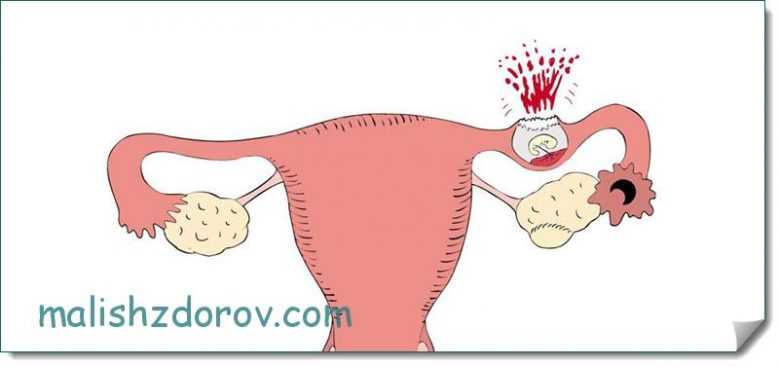
In the early stages, it is quite difficult to suspect an ectopic pregnancy. It can proceed as usual, accompanied by toxicosis and two lines on the test. As the embryo enlarges, the woman notices that she has severe shooting, stabbing, or cutting on the side where the embryo implanted. Increasing in size, the fertilized egg affects the walls of the fallopian tube and can even provoke its rupture.
The danger of the described condition is that it occurs without visible symptoms, and if diagnosed late, it is accompanied by dangerous complications for the life and health of the patient.
Fetal freezing
At the beginning of pregnancy, fetal freezing may occur. In later stages, pathology is much less common. The greatest danger remains during the first 12 weeks. This is the so-called short term. During a frozen pregnancy, a girl may not experience any symptoms for quite a long period. A cutting, sharp or cramping pain occurs when embryonic tissue is rejected. This process may be accompanied by bleeding, fever and other severe symptoms.
Expert opinion
Ksenia Dunaeva
User experience expert and comment moderator. Higher medical education and more than 5 years of actual practice.
Ask Ksenia
In addition to the conditions described above, discomfort during pregnancy may occur due to the development of cystitis, pyelonephritis, corpus luteum cyst and other pathologies. Many mothers often complain that their uterus seems to be hardening. This indicates increased uterine tone. Pain on the left or right may indicate an inflammatory process in the ovaries. If painful sensations are regular, it is necessary to look for their cause.
Nagging pain
Painful sensations may not be related to pregnancy at all. For example, nagging pain in the lower abdomen may be a consequence of certain congestion in different parts of the intestines, constipation.
Although these situations are often provoked by changes in the hormonal levels of pregnant women. After all, progesterone, the main hormone in this condition, is designed to protect the fetus and prevent miscarriages. Therefore, it acts on the muscles of the uterus in order to suppress its possible mobility. At the same time, the same hormone “inhibits” contractions of the intestinal muscles, since they have the same source of innervation. The result of such a violation of intestinal functionality can be constipation and other gastrointestinal problems that cause nagging pain.
Stitching pains, causes of lumbago in the uterus during pregnancy
During pregnancy, women begin to pay special attention to their own well-being and often complain of a kind of lumbago in the uterine area. This condition turns out to be very frightening for most expectant mothers, since the epicenter of pain is in close proximity to the baby. However, such painful sensations are not always a threat, since they can be provoked by completely natural physiological causes, so in this article we will consider all possible factors that can cause pain and the degree of their danger. Gynecologists identify several main causes of pain in the perineum:
- Changes in hormonal levels. Changes in the functioning of the endocrine system in some cases lead to excessive dryness in the vagina. This causes severe discomfort and can cause pain during sexual intercourse.
- Physiological changes in the pelvic area. Already from the first days of pregnancy, the female body begins active preparation for the upcoming birth and the pelvic area takes the main blow. Providing the child with an unimpeded exit, the pelvic bones prepare for divergence, and the ligamentous apparatus is continuously stretched under the pressure of an actively growing uterus. These factors can lead to stabbing sensations during sexual intercourse. This problem can be solved by changing the sexual position; in particular, it is recommended to try the cowgirl position, in which the woman can control the depth of penetration and stop at the first sign of discomfort.
- Intensive growth of the uterus. A child who is actively gaining weight, together with the uterus, is able to exert strong pressure on nearby internal organs and muscles, thereby provoking the appearance of unpleasant sensations.
- Sprain. As the uterus grows, the ligamentous apparatus, which is designed to support the pelvic area and vagina, is stretched. In some cases, this happens so quickly that the woman begins to experience severe discomfort in the lower abdomen and groin;
- Infectious diseases of the reproductive system. The penetration of infectious pathogens into the expectant mother's body can lead to pain both in the vagina and on the external genitalia. Such infections occur quite often during pregnancy, since the protective forces of the female body do not cope with their responsibilities sufficiently. As a rule, such diseases are accompanied by other unpleasant symptoms, such as itching and heavy discharge. In this case, it is recommended to immediately contact your doctor to identify the cause and prescribe effective treatment. It should be borne in mind that while carrying a child, a woman is prohibited from taking most medications, so treatment can take a lot of time.
- Ectopic pregnancy. If the pain becomes more intense over time and is accompanied by other dangerous symptoms, such as uterine bleeding, hyperthermia, pain in the lumbar region and general weakness, then this may indicate abnormal attachment of the fertilized egg. An ectopic pregnancy at the very beginning is completely asymptomatic and can only be detected by a competent specialist, but it poses a great threat to the life and health of a woman, so at the first signs of illness you should immediately consult a doctor.
Of all the listed cases, a woman should not worry only if the pain is caused by natural physiological changes in the woman’s body or hormonal fluctuations. If intense pain occurs due to an infection or ectopic pregnancy, then medical care cannot be avoided.
Stitching pain in the lower abdomen during pregnancy
Another type of pain is stabbing pain - the appearance of such pain sometimes indicates the presence of diseases: acute appendicitis, cholecystitis, pancreatitis, cystitis. With cystitis, the bladder is inflamed and urination is difficult. With inflammatory processes in the liver and pancreas, stabbing pain in the lower abdomen can radiate, and it is more difficult to establish an accurate diagnosis; laboratory tests will be required. Infectious diseases can also become a source of problems, including sexually transmitted infections.
Isthmic-cervical insufficiency is a special pathology, most often developing as a complication after cervical injuries. And the cervix is also injured during previous births, during abortions; there may also be a congenital structural anomaly, which also gives pain reactions. As a result of injuries, the uterus cannot properly fix the fertilized egg, it descends and causes pain. In a bad scenario, a miscarriage may occur.
Pain in the right abdominal area
The appearance of fairly intense pain in the lower abdomen may indicate to an experienced doctor the presence of such serious gynecological abnormalities as a tumor on one of the ovaries, a cystic formation, or an ectopic pregnancy.
Or these are manifestations of diseases of the gastrointestinal tract, genitourinary tract, and a number of infections of different localization. For example, pain in this area occurs with diagnoses such as enteritis, renal colic, pyelonephritis and a number of others. Even minor injuries, or even depressive states of the expectant mother, can provoke muscle spasms and, as a result, pain.
If there is pain in the lower abdomen on the left
Many important organs are located on the left side of the abdominal cavity, and they can “signal” their problems with pain. For example, pain in the lower left abdomen sometimes occurs due to problems with the spleen. Pathologies of the stomach and incorrect position of the diaphragm also react in a similar way.
Each of the probable diagnoses, in addition to pain, also has other symptoms, which will help the specialist make a decision and identify the cause of the deviations. For example, during inflammatory processes in the spleen, the skin around the navel is simultaneously noted to be blue, and the pain becomes sharp when moving. The stomach also makes its problems known: nausea, vomiting, and possibly an increase in body temperature.
Even pneumonia can radiate down the abdomen when coughing, so it is impossible to diagnose the cause of the problem without medical help.
Pain in the second trimester of pregnancy
The second trimester includes the following weeks - 13, 14, 15, 16, 17, 18, 19, 20, 21, 22, 23, 24, 25. At this stage, the risk of miscarriage or fetal death decreases, but there is a threat of others, no less dangerous problems. The causes of various complications include hormonal imbalances in women, infectious and inflammatory diseases, poor nutrition and other provoking factors. As in the first weeks, the nature of the pain can be physiological or pathological.
You might be interested in: Vaginal cyst
Physiological reasons
A slight nagging pain in the second trimester is often explained by an increase in the size of the uterus. At the same time, its fibers are strained and stretched. In addition, the enlarged fetus puts pressure on all internal organs, including the stomach, liver, and intestines. All this can provoke so-called harmless pain. In addition, discomfort may appear after eating, which is explained by a decrease in gastric motility due to the influence of hormones on the gastrointestinal tract. This periodic problem can be eliminated by correcting the diet. You should fill your diet with vegetables, fruits, grains and proteins. It is important to avoid heavy, fatty, spicy, fried and smoked foods. Such foods negatively affect digestion.
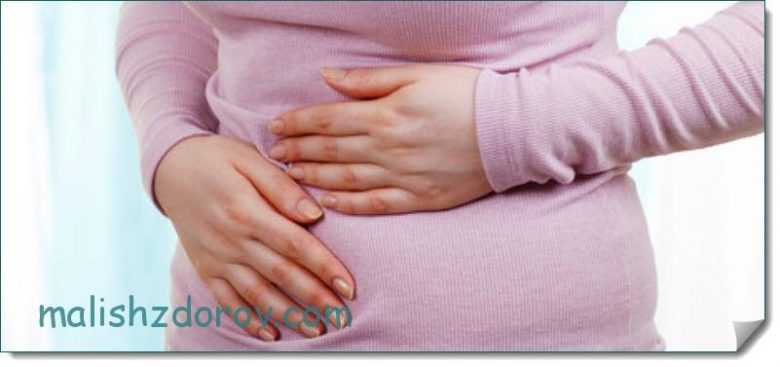
Another reason why back discomfort and pain radiating to the leg may occur is an increase in the load on the muscles and spine. This happens due to the growth of the fetus and a shift in the center of gravity of the expectant mother. This can cause pain in both the upper and lower back.
Sometimes discomfort appears after sex. If a woman encounters such a problem, she should definitely inform her doctor about it.
Pathological pain in the second trimester
Mid-pregnancy is considered the easiest period, but this is not always the case. Many mothers face various problems. One of them is indigestion. Discomfort can be observed in the lower abdomen, side, above, slightly above the navel, on the left or right. Associated symptoms include diarrhea or, conversely, constipation, accumulation of gases, belching, heartburn, pain when pressing on the stomach area and other manifestations.
Appendicitis
It is very important to distinguish a physiological disorder from some dangerous pathologies, such as appendicitis.
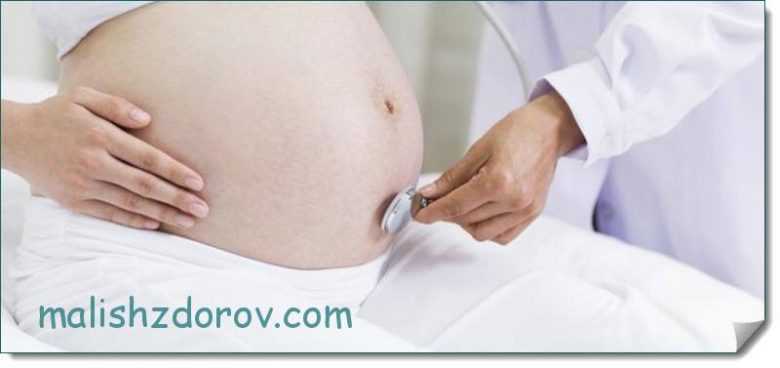
Inflammation of the appendix is accompanied by the following characteristic symptoms:
- Weakness, apathy, drowsiness.
- Increased body temperature, dry mouth.
- Rapid breathing and pulse.
- Vomiting, flatulence, loss of appetite.
- Tingling or sharp pain near the navel or radiating to the right.
If such a clinical picture appears during pregnancy, you should immediately call an ambulance. Every minute of delay can cost mother and baby their lives.
Cystitis
Stabbing, cutting or burning pains radiating to the lower abdomen can occur with cystitis. At the same time, the pregnant woman’s body temperature may rise while in the toilet, and the mother may notice blood in the urine during urination.
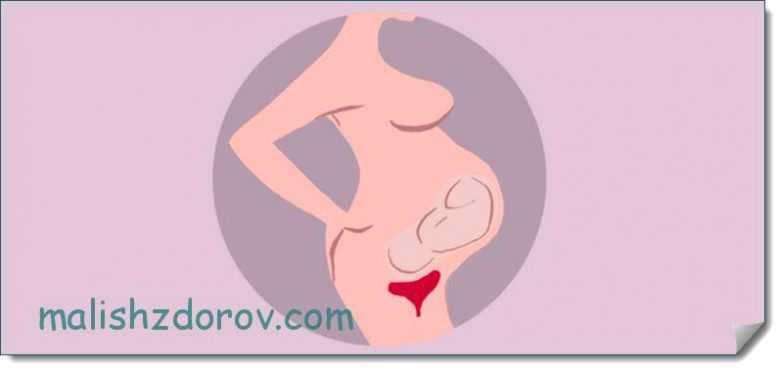
What should you do if you notice such symptoms? The first thing to do is seek medical help. Self-treatment in such a situation is not allowed. To alleviate the condition, you are allowed to drink No-Shpu. It is not recommended to take any other drugs, as this can cause harm to mother and baby.
Pancreatitis
When the pancreas becomes inflamed, mommy may experience various types of pain. Discomfort, as a rule, appears slightly to the left and in the middle and spreads upward. The pain can be either constant or periodic, cramping. Sometimes they radiate to the scapula area. Pain increases with physical exertion, such as walking, turning, coughing or sneezing.
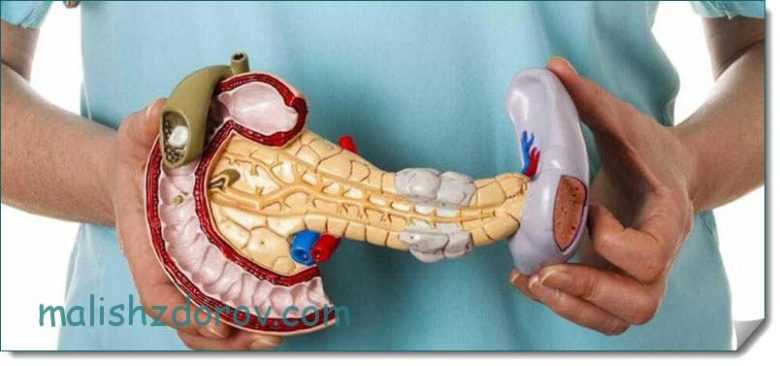
In addition, the symptoms are as follows:
- Decreased appetite.
- Nausea, vomiting.
- Pale skin.
- Slight increase in body temperature.
Many women confuse the manifestations of pancreatitis with toxicosis. It is important to understand that toxicosis is not normally accompanied by pain. If you encounter this condition, you should definitely visit a doctor.
Premature birth
In the second trimester, local painful sensations in the upper or lower abdomen may indicate such a dangerous condition as the premature birth of the baby.
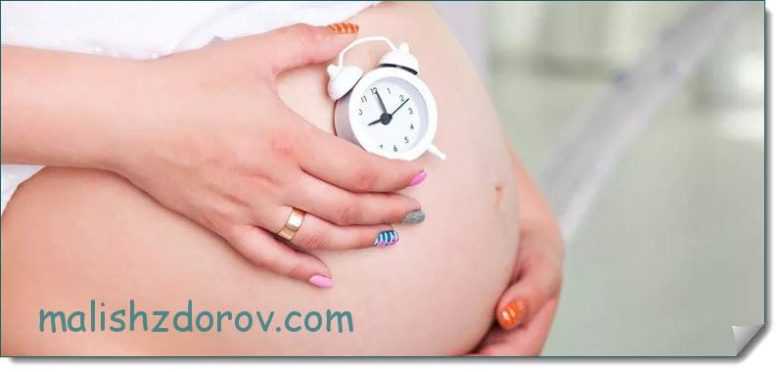
It is necessary to immediately call an ambulance if the following symptoms develop:
- My stomach and abs hurt, my uterus turns to stone.
- The woman is feeling sick.
- The pain is similar to that experienced during contractions.
- My stomach hurt, then it stopped, but after a while the cramps returned.
- The top of the tummy becomes like stone.
- Wet spots appear on the laundry.
- Contractions begin, but the expected birth is still far away.
You may be interested in: 17th week of pregnancy: fetal development and woman’s sensations
Premature labor often begins due to placental abruption. Pathology can also be provoked by physical activity, bad habits, and heavy lifting. The prognosis is also unfavorable for mothers, who are often on edge due to conflicts at home and at work.
If you suspect the onset of premature labor, you should go to the hospital immediately.

